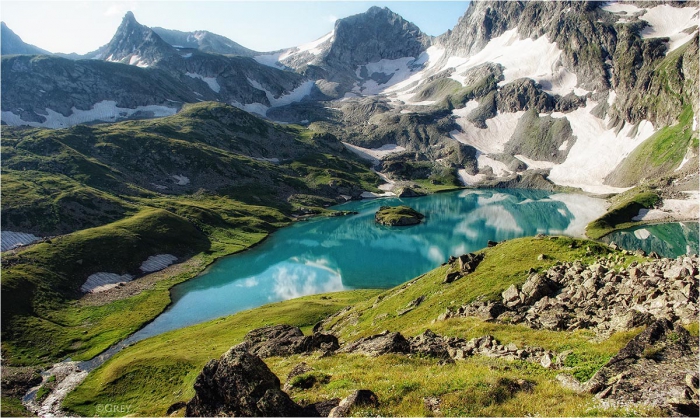Caucasian State Natural Biosphere Reserve named after H. G. Shaposhnikova
Caucasian Reserve - The largest in the territory and the oldest specially protected natural territory in the North Caucasus. Located within three constituent entities of the Russian Federation - Krasnodar Territory, the Republic of Adygea and the Karachay-Cherkess Republic.
The entire territory of the reserve is divided into six departments: West, Northern, South, Hostinsky, East and Southeast. Interestingly, two natural climatic zones with a moderate and subtropical climate are combined here. This largely determines the originality of the region. The main Caucasian ridge, which stretched one hundred kilometers from the North-West to the southeast, is the heart of the Caucasus Reserve. The maximum height of the mountains in the reserve is 3345 m above sea level. This is the top of Tsakhvo.
In the entire reserve there are more than 60 glaciers, a lot here and caves. Only in the Lagonakian highlands there are about 130. The amazing natural architectural construction is the Caucasian karst caves. These underground spaces are formed when leaching soluble rocks and can communicate with each other long narrow strokes or labyrinths.
Rivers and lakes in the reserve make up 1.9% of the total area, they are surprisingly beautiful, there are more than 120 them. The largest lake area is silence, the aqueous mirror is about 200,000 m2. Not less famous Lakes Huko, Blue, Cardywach, InPSI, etc.

The rivers of the Caucasian Reserve are predominantly mountainous, rapid and fast, with thresholds and waterfalls. The most famous - Shahe, White Uchar, Mzymt, Sochi.
History of creating a reserve

The history of the Caucasian Reserve has about 200 years. In 1888, the "Grand-Magnish Kuban Hunt" was organized. The great princes Peter Nikolaevich and Georgy Mikhailovich took about 80,000 tents of the Earth for rent from the forest dacha of the Ministry of State Property and the Kuban Regional Military Board. From now on, the princes and their retinue were right to hunt here.

In 1909, Khaccatur (Christopher) Georgievich Shaposhnikov, the Russian researcher and the entomologist, appealed to the Academy of Sciences with the scientific substantiation of the need to protect the Kuban expanses, mainly due to a sharp drop in the size of the bison. However, he was able to succeed only in 15 years: on May 12, 1924, the Caucasian Zubne Reserve was founded.
Khaccatur Shaposhnikov remained his director for 8 years. All this time, he stubbornly worked on the creation of a unique complex, carefully picked up the hurkers, engaged in educational activities, wrote scientific works. The tragedy occurred suddenly. By the decision of the special triple of the UNKVD of the Krasnodar Territory, Khaccatur Shaposhnikov was declared a traitor to the Motherland and shot on January 25, 1938. Only in 50 years he was posthumously rehabilitated. In 2008, the Caucasus Reserve was assigned the name of Christopher Georgievich Shaposhnikov. Since 1999, the Caucasus Reserve has been included in UNESCO World Heritage List.
Plant world of the reserve

The plant's vegetation world is represented by more than 3000 species, while half of them are higher vascular plants. Interestingly, every fifth plant is endemic or relic. Trees and shrubs make up 165 species, of which 142 species are leaf falling, 16 - evergreens and deciduous and 7 - coniferous.
TIS Berry (Taxus Baccata) is one of the most common wood species here, it is almost everywhere. This tree lives to 2500 years. A tree is also known, the age of which is 4,000 years, and the diameter is 4 m. Wood, bark, needles and seeds of this tree poisonous for a person and some animals. In antiquity there was a proven way to poisoning nonsense: he was served wine in the carved Cup from Tis.
Together with the Samshet (Buxus), the TIS Berry forms in the Caucasus Reserve Tiso-Samshite Grove - a unique monument of ancient nature on the eastern slope of Mount Akhun in the Khostinsky district of the city of Sochi. This grove existed another 30 million years ago and was miraculously preserved to the present day. Tiso-browning grove is a separate area of \u200b\u200bthe reserve - Hostinsky.

Here you can find three types of flowers from the genus Rhododendron (rhododendron) of the family of herase. It is believed that this plant has a unique ability to heal the poisoning of mercury couples.
In the Red Book of Russia, 55 species of flowering plants are listed, which are found in the Caucasus Reserve. However, there are those who, although they did not fall on her pages, but still in nature are extremely rare. This is, for example, the rununculus Helenae (Ranunculus Helenae) and the Circassica MascaSica (Daphne Circassica).
In the reserve it grows at least 720 species of mushrooms. There are really unusual and affecting the imagination of mushrooms - representatives of the tropical and subtropical zones. For example, a lattice red (Clathrus Ruber) is a unique flower mushroom, the fruit body of which resembles a red grid.
Animal peace of the reserve

The fauna of the Caucasian Reserve includes 89 species of mammals, 248 - birds, including 112 nesting, 15 species of reptiles, 9 - amphibians, 21 - fish, 1 - round-chapband, more than 100 mollusks and more than 10,000 insects. Representatives of the largest animals - Bison (Bonasus), noble deer (Cervus Elaphus), a brown bear (Ursus Arctos), Serne (Rupicarpa Rupicarpa), European roe (Capreolus Capreolus) and Lynx.
Initially, the reserve was created precisely to protect the bison, so these animals are particularly trembling here. In the second half of the 20th century, targeted work was conducted in the reserve to restore the number of this species, since it was almost completely exterminated in the previous century.

One of the largest representatives of the fauna - the Transcaucasian Brown Bear (Ursus Arcto Syriacus). It is interesting that the Central Asian brown bears are three times less than their Far Eastern counterparts, but in force and dexterity they are not inferior to them.
Keep in mind if you go with a student trip to the Caucasus, such large animals, like a bison, bear, deer or badger, can not meet. They are wary, attentive and trying to avoid meetings with a person. But a few hundred insects will meet you necessarily. The life of each species is no less interesting than the biology and behavior of the vertebral animals. Many among them and the representatives of the Red Book of Russia: this is Oak Usach (CERAMBYX CERDO), and a deer beetle (Lucanus Cervus), and Carabus Caucasicus. Two types of butterflies - Mahaon (Papilio Machoon) and Podalirius (iPhiclides Podalirius) - are found almost everywhere, so in the summer you will definitely see them.

Add a comment:



